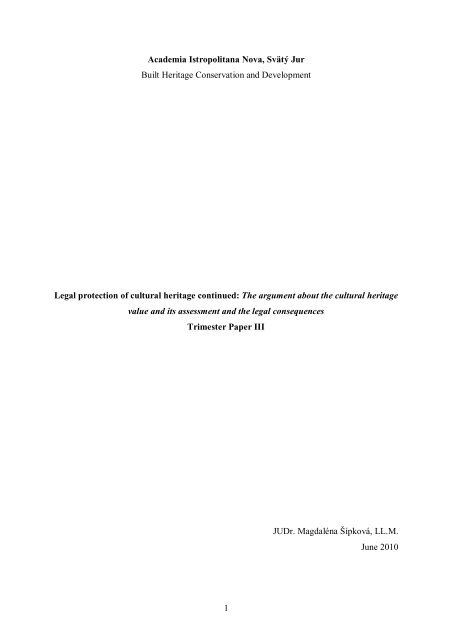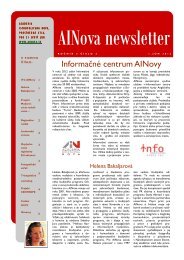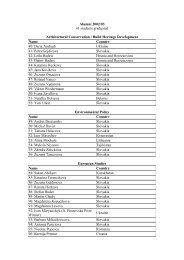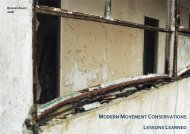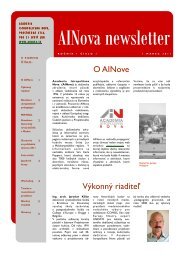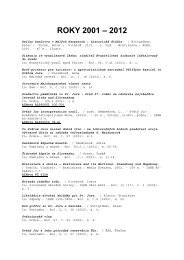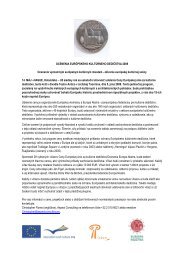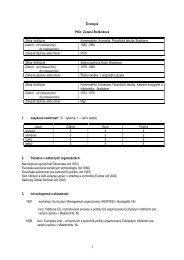The Argument about the Cultural Heritage Value and its Assessment ...
The Argument about the Cultural Heritage Value and its Assessment ...
The Argument about the Cultural Heritage Value and its Assessment ...
You also want an ePaper? Increase the reach of your titles
YUMPU automatically turns print PDFs into web optimized ePapers that Google loves.
Academia Istropolitana Nova, Svätý Jur<br />
Built <strong>Heritage</strong> Conservation <strong>and</strong> Development<br />
Legal protection of cultural heritage continued: <strong>The</strong> argument <strong>about</strong> <strong>the</strong> cultural heritage<br />
value <strong>and</strong> <strong>its</strong> assessment <strong>and</strong> <strong>the</strong> legal consequences<br />
Trimester Paper III<br />
JUDr. Magdaléna Šípková, LL.M.<br />
June 2010<br />
1
I. Introduction:<br />
In <strong>the</strong> first trimester papers 1 I have dedicated my attention to <strong>the</strong> general study of legal<br />
framework for <strong>the</strong> protection of cultural heritage in Slovak Republic, which primarily rests<br />
with <strong>the</strong> Act n. 49/2002 Coll. on <strong>the</strong> protection of monuments <strong>and</strong> historic sites (<strong>the</strong><br />
„Monuments Act“) as amended by <strong>the</strong> Act n. 479/2005 a 208/2009. Finally I would like to<br />
narrow <strong>the</strong> scope of my paper to <strong>the</strong> specific substantive <strong>and</strong> procedural aspects of <strong>the</strong><br />
Monuments Act: <strong>the</strong> assessment of cultural heritage value as <strong>the</strong> criterion for <strong>the</strong> inscription<br />
into <strong>the</strong> National <strong>Heritage</strong> list, <strong>the</strong> steps in <strong>the</strong> administrative procedure for inscription <strong>and</strong> <strong>the</strong><br />
scope of substantive protection afforded to <strong>the</strong> objects which have not been inscribed into <strong>the</strong><br />
National <strong>Heritage</strong> List, but where <strong>the</strong> procedure has been instituted by <strong>the</strong> competent<br />
authorities.<br />
In order to clarify <strong>the</strong>se aspects I will use specific type of heritage: <strong>the</strong> industrial<br />
heritage in Bratislava. This heritage type is <strong>the</strong> most neglected one <strong>and</strong> receives <strong>the</strong> least<br />
attention. <strong>The</strong> lack of support from <strong>the</strong> public can be perhaps attributed to <strong>the</strong> absence of <strong>the</strong><br />
“romantic” qualities, which <strong>the</strong> wider public usually associates with <strong>the</strong> heritage (i.e. castles,<br />
manor houses etc.). <strong>The</strong> industrial monuments are admired by enthusiasts or experts who<br />
appreciate <strong>the</strong>ir special architectural qualities. And that maybe <strong>the</strong> reason why <strong>the</strong> majority of<br />
this heritage in Bratislava has not managed to escape from <strong>the</strong> bulldozers.<br />
In my work I will highlight particular case of Gumon factory, which has been<br />
demolished during public holiday between 29 th August <strong>and</strong> 1 st September 2008, when most of<br />
general public was not present in Bratislava <strong>and</strong> when <strong>the</strong> competent authorities were not in<br />
service 2 . It seemed to be coordinated action prepared by <strong>its</strong> owners, who used all of <strong>the</strong><br />
available legal <strong>and</strong> illegal means to bring this outcome.<br />
<strong>The</strong> purpose of this paper is not just 'digging in <strong>the</strong> mud’ <strong>and</strong> bringing to <strong>the</strong> light <strong>the</strong><br />
well known facts of <strong>the</strong> Gumon case, but to draw a conclusion for <strong>the</strong> future <strong>and</strong> to prevent<br />
1 See Šípková, M.: Legal protection of cultural heritage: Does <strong>the</strong> legal framework strike a right balance<br />
between public <strong>and</strong> private interests, Trimester Paper, Academia Istropolitana Nova, Svätý Jur, 2009.<br />
2 It still remains in my memory, how astonished I was to find out upon my arrival from holiday that <strong>the</strong> beautiful<br />
building of Gumon factory, disappeared.<br />
2
similar cases by clarifying <strong>the</strong> scope of <strong>the</strong> legal framework <strong>and</strong> examining <strong>the</strong> possibilities to<br />
save <strong>the</strong> heritage in <strong>the</strong> future.<br />
II.Gumon - Hi(S)tory<br />
<strong>The</strong> site of former Gumon factory is situated in <strong>the</strong> south-eastern direction off <strong>the</strong><br />
historical centre of Bratislava on <strong>the</strong> broad plain near Danube. This area regularly flooded by<br />
Danube has been only scarcely inhabited with farmsteads until <strong>the</strong> regulation of Danube river<br />
in <strong>the</strong> last third of 18 th century. Due to <strong>its</strong> location <strong>and</strong> <strong>the</strong> passage of several roads <strong>and</strong> horse<br />
railway (1840 - 1872) <strong>the</strong> site has been predetermined for development of industry. <strong>The</strong><br />
political compromise between Austria <strong>and</strong> Hungary in 1867 removed <strong>the</strong> last obstacles to <strong>the</strong><br />
industrial development <strong>and</strong> Bratislava soon became one of <strong>the</strong> most important industrial<br />
centres of Austrian – Hungarian empire 3 . Gumon factory had been established in Bratislava<br />
by Viennese entrepreneur Otto Bondy as a branch of his already existing Cable factory. <strong>The</strong><br />
management of <strong>the</strong> factory was h<strong>and</strong>ed over to his son Egon Bondy in 1910, who was due to<br />
his success able to acquire similar factories elsewhere in Central Europe. Egon Bondy bought<br />
<strong>the</strong> plots at south-eastern direction from <strong>the</strong> city centre at nowadays location <strong>and</strong> on 13 th July<br />
1911 created new „Gumon factory Mlynské Nivy“, which specialised in <strong>the</strong> production of<br />
early plastics, namely bakelite 4 . Gumon factory has been in operation throughout <strong>the</strong> first<br />
Czechoslovak Republik (1918-1939), <strong>and</strong> period between 1948 - 1989 in <strong>the</strong> legal form of<br />
state - owned enterprise (Gumon n.p.) <strong>and</strong> after 1990 in <strong>the</strong> form of corporation (Gumon<br />
Bratislava a.s.). Year 2005 has been milestone for <strong>its</strong> future: <strong>the</strong> plots with <strong>the</strong> adjoining<br />
factory buildings have been acquired into <strong>the</strong> ownership of a company which terminated <strong>the</strong><br />
production in Gumon. Almost all of <strong>the</strong> buildings belonging to <strong>the</strong> former Gumon factory<br />
have been demolished in <strong>the</strong> symbolic dates between Friday 29 th August <strong>and</strong> Monday 1 st<br />
September 2008, where 29 th August is reminder of Slovak National Uprising in 1944 against<br />
3 Between 19th <strong>and</strong> 20th century major factories were built <strong>and</strong> operating, in particular : Tobacco plant,<br />
Kuhmayer's plant (technical glass), Patrónka, Gruneberg’s plant (brushes), Marschall’s plant (carrriages)<br />
Dynamitka, Durvay’s brick plant, Menzl’s plant for cardboard <strong>and</strong> asphalt, Klingerka, Kablovka, Apollo<br />
refinery, Stollwerck plant, Sfinx (smalto kitchenware), Siemens-Schuckert’s plant (BEZ), Cvernovka, Matador,<br />
Bro<strong>the</strong>rs Harschs’ saw mill, Danubius (textiles) <strong>and</strong> Gumon.<br />
4 Bakelite was an early plastic developed in 1907–1909 by Belgian chemist Dr. Leo Baekel<strong>and</strong>.It was a material<br />
with thous<strong>and</strong> uses: dial telephones, radios, cameras, jewellery, wire installer material etc. It has become a<br />
st<strong>and</strong>ard item in <strong>the</strong> family home of <strong>the</strong> 1930s <strong>and</strong> 1940s. http://en.wikipedia.org/wiki/Bakelite<br />
3
<strong>the</strong> Nazis <strong>and</strong> 1 st<br />
September is a Constitution Day to remind declaration of Slovak<br />
Constitution in 1992, which had <strong>the</strong> ambition to establish democracy.<br />
III. Gumon – his legal story– substantive <strong>and</strong> procedural aspects<br />
<strong>Assessment</strong> of <strong>the</strong> cultural heritage value<br />
<strong>The</strong> whole legal argument usually surrounding cultural monuments should be centered<br />
on <strong>the</strong> question whe<strong>the</strong>r <strong>the</strong>y have a cultural heritage value <strong>and</strong> thus deserve to be protected.<br />
<strong>The</strong> burden of proof rests with <strong>the</strong> Ministry of Culture <strong>and</strong> Monuments Board against <strong>the</strong><br />
opponents/adversaries who should attempt to question <strong>and</strong> to refute <strong>the</strong> arguments in favour<br />
of <strong>the</strong> cultural heritage value. But as I will demonstrate, this was not <strong>the</strong> case in <strong>the</strong> story of<br />
Gumon, where <strong>the</strong> party opposed to <strong>the</strong> protection invoked o<strong>the</strong>r grounds for challenging it.<br />
Pursuant to Act n. 49/2002 Coll. on <strong>the</strong> protection of monuments <strong>and</strong> historic sites (<strong>the</strong><br />
„Monuments Act“) as amended by <strong>the</strong> Act n. 479/2005 <strong>and</strong> 208/2009 Coll. applicable from 1 st<br />
of June 2009 cultural monument is a movable or an immovable object, which has a cultural<br />
heritage value 5 . <strong>The</strong> cultural heritage value or a cultural interest is <strong>the</strong> objective <strong>and</strong> <strong>the</strong> sole<br />
determining criteria for assessment of cultural heritage. It is defined as an aggregate of an<br />
important historic, social, rural, urban, architectonic, scientific, technical, visual art, artistic<br />
<strong>and</strong> craft values 6 . Only those movable <strong>and</strong> immovable objects having such a value can be<br />
declared as cultural monuments <strong>and</strong> inscribed on <strong>the</strong> National <strong>Heritage</strong> List.<br />
At which stage of <strong>the</strong> specialized administrative procedure for <strong>the</strong> inscription of cultural<br />
monument on <strong>the</strong> National <strong>Heritage</strong> List is <strong>the</strong> object protected<br />
Pursuant to § 2 section 1 second sentence of <strong>the</strong> Monuments Act objects or property in<br />
relation to which a specialized administrative procedure for inscription on <strong>the</strong> National<br />
5<br />
Granada Convention defines as monuments “all buildings <strong>and</strong> structures of conspicuous historical,<br />
archaeological, artistic, scientific, social or technical interest, including <strong>the</strong>ir fixtures <strong>and</strong> fittings.” See <strong>the</strong><br />
Convention for <strong>the</strong> protection of <strong>the</strong> architectural heritage of Europe, Granada, 3.10. 1985, Council of Europe,<br />
European Treaty Series – No. 121<br />
6 § 2 section 2 of <strong>the</strong> Act n. 49/2002 Coll. on <strong>the</strong> protection of monuments <strong>and</strong> historic sites (<strong>the</strong> „Monuments<br />
act“) as amended by <strong>the</strong> Act n. 479/2005 a 208/2009.<br />
4
<strong>Heritage</strong> List has been commenced, shall also be considered as a cultural heritage. In order<br />
to determine <strong>the</strong> duration of <strong>the</strong> legal protection of <strong>the</strong> objects, potential monuments, it is<br />
necessary to answer <strong>the</strong> question when <strong>the</strong> administrative procedure begins. It is not so clear<br />
from <strong>the</strong> wording of §15 of <strong>the</strong> Monuments Act: Ministry of Culture shall declare a movable<br />
or immovable object of cultural heritage value as a cultural monument on a proposal from<br />
central Monuments Board. <strong>The</strong> owner of <strong>the</strong> object is a party to <strong>the</strong> administrative procedure<br />
<strong>and</strong> has a right to submit his observations (§ 15 section 3). <strong>The</strong>refore it has to be inferred that<br />
<strong>the</strong> procedure starts upon <strong>the</strong> notification of <strong>the</strong> procedure to <strong>the</strong> owner. Such a notification<br />
creates legal effect for <strong>the</strong> owner by imposing st<strong>and</strong>still obligation – <strong>the</strong> owner is obliged i) to<br />
abstain from any action which would damage <strong>the</strong> object <strong>and</strong>, ii) to enable state officials to<br />
conduct <strong>the</strong> historical, architectural <strong>and</strong> o<strong>the</strong>r survey of <strong>the</strong> building for <strong>the</strong> purpose of <strong>the</strong><br />
procedure. <strong>The</strong> procedure is brought to an end when <strong>the</strong> final decision against which <strong>the</strong>re is<br />
no appeal, has become res iudicata - entered into force. <strong>The</strong> final decision confirms<br />
inscription or rejects it (§ 15 section 5).<br />
Is <strong>the</strong> nature of <strong>the</strong> decision making purely legal <strong>and</strong> technocratic<br />
Pursuant to <strong>the</strong> old version of <strong>the</strong> Monuments Act applicable until 1 st of June 2009 (to<br />
<strong>the</strong> facts of <strong>the</strong> Gumon case) <strong>the</strong> first instance authority taking <strong>the</strong> decision on <strong>the</strong> application<br />
for inscription of <strong>the</strong> monument has been vested with <strong>the</strong> Ministry of Culture. <strong>The</strong> application<br />
for inscription has been elaborated <strong>and</strong> submitted by <strong>the</strong> central Monuments Board<br />
(Monuments Board of Slovak Republic). <strong>The</strong> owner as a party to <strong>the</strong> procedure had <strong>the</strong> right<br />
to file special legal appeal against <strong>the</strong> decision of <strong>the</strong> Ministry (“rozklad”), which would be<br />
reviewed by <strong>the</strong> Minister of Culture consulting special committee (“rozkladová komisia”)<br />
whose opinion is not binding on Minister. Thus <strong>the</strong> nature of <strong>the</strong> decision-making had been<br />
political <strong>and</strong> precisely for this reason <strong>the</strong> real purpose behind § 2 section 1 second sentence to<br />
prevent demolition of objects before <strong>the</strong> completion of administrative procedure has been<br />
negated.<br />
<strong>The</strong> amendment of <strong>the</strong> Monuments Act n. 208/2009 Coll. applicable since 1st of June<br />
2009 attempts to resolve this problem by transferring <strong>the</strong> administrative procedure from <strong>the</strong><br />
political ministerial level to <strong>the</strong> specialized technocratic level of central Monuments Board,<br />
where it really should have been from <strong>the</strong> moment <strong>the</strong> Monuments Act entered into force (1 st<br />
April 2002). Nowadays <strong>the</strong> application for inscription is submitted by <strong>the</strong> regional<br />
5
Monuments Board or section of <strong>the</strong> central Monuments Board to <strong>the</strong> central Monuments<br />
Board, which adopts <strong>the</strong> first instance decision subject to appeal to <strong>the</strong> Ministry of Culture<br />
still retaining <strong>the</strong> final control over <strong>the</strong> inscriptions.<br />
Was <strong>the</strong> administrative procedure in <strong>the</strong> case of Gumon without unnecessary delay<br />
I will resume individual procedural acts in <strong>the</strong> administrative procedure in <strong>the</strong><br />
chronological order:<br />
- 5 th December 2007 - submission of application for inscription (návrh na vyhlásenie) by<br />
<strong>the</strong> central Monuments Board to <strong>the</strong> Ministry of Culture – <strong>the</strong> procedure has not started<br />
yet,<br />
- 8 th February 2008 - notification of <strong>the</strong> start of administrative procedure at <strong>the</strong> Ministry of<br />
Culture to <strong>the</strong> parties - <strong>the</strong> owner as a party to <strong>the</strong> procedure has to submit <strong>the</strong><br />
observations within 10 days deadline,<br />
- 21 st February 2008 - observations of parties – negative opinion of <strong>the</strong> owner presented by<br />
his legal representative,<br />
- 25 th March 2008 - opinion of Mestský ústav ochrany pamiatok (City Institute for <strong>the</strong><br />
Protection of Monuments) – specialized body consulted according to <strong>the</strong> § 15 section 2,<br />
- 6 th May 2008 - adoption of decision on inscription of building “lisovňa” (press shop) into<br />
<strong>the</strong> National <strong>Heritage</strong> List by <strong>the</strong> Ministry of Culture (decision of first instance),<br />
- 30 th May 2008 - legal representative of <strong>the</strong> owner appeals against <strong>the</strong> decision on <strong>the</strong><br />
inscription, appeal is reviewed by <strong>the</strong> Minister of Culture,<br />
- 20 th August 2008 – Minister adopts decision (of second instance) to set aside <strong>the</strong> decision<br />
on <strong>the</strong> inscription (decision of first instance) <strong>and</strong> forward it for new procedure at <strong>the</strong> first<br />
instance,<br />
- 29 th August <strong>and</strong> 1 st September 2008 <strong>the</strong> owner orders demolition of almost all of <strong>the</strong><br />
buildings of Gumon complex,<br />
- 29 th August – activists <strong>and</strong> one person from regional Monuments Board acting in private<br />
capacity intervene at <strong>the</strong> site, call police which does not act against <strong>the</strong> demolition,<br />
- 11 th September 2008 – survey of <strong>the</strong> site by <strong>the</strong> regional Monuments Board,<br />
- 6 th November 2009 - survey of <strong>the</strong> site by <strong>the</strong> Ministry of Culture<br />
- 30 th November 2009 - decision on termination of administrative procedure due to non<br />
existence of subject of protection.<br />
6
Selected aspects of <strong>the</strong> procedure<br />
As regards <strong>the</strong> speed of <strong>the</strong> procedure, we see that it has not started until early<br />
February, so <strong>the</strong> Ministry took two months from <strong>the</strong> delivery of <strong>the</strong> application of central<br />
Monuments Board to start procedure by notifying <strong>the</strong> owners. During this time <strong>the</strong> buildings<br />
were not protected. <strong>The</strong>re was fur<strong>the</strong>r delay in decision making of 60 days in addition to 30<br />
days within which <strong>the</strong> administrative authority is obliged to decide in ordinary circumstances.<br />
So <strong>the</strong> procedure was lengthy with severe delays suggesting reluctant attitude of <strong>the</strong> Ministry<br />
of Culture to act to protect <strong>the</strong> potential monument. <strong>The</strong> Ministry of Culture request for<br />
opinion of Mestký ústav, which highlighted <strong>the</strong> building of “lisovňa (press shop)” as <strong>the</strong> most<br />
valuable one. On <strong>the</strong> basis of this <strong>the</strong> Ministry decided to narrow down <strong>the</strong> scope of protection<br />
from <strong>the</strong> originally proposed three buildings (lisovňa, nástrojáreň, kotolňa) to “lisovňa”. But<br />
this can also easily understood as a compromise <strong>and</strong> deference to <strong>the</strong> exigencies of <strong>the</strong> owner<br />
which contributed to <strong>the</strong> destruction of <strong>the</strong> potential monument.<br />
<strong>The</strong> justification for declaration of cultural monument is only <strong>its</strong> cultural heritage<br />
value. According to <strong>the</strong> abovementioned procedural documents <strong>the</strong> value of Gumon, esp.<br />
“lisovňa” is constituted by <strong>its</strong> historical, urban <strong>and</strong> architectural values. <strong>The</strong> building of<br />
“lisovňa” was built in 1911 <strong>and</strong> survived all <strong>the</strong> latest interventions <strong>and</strong> additions in unspoilt<br />
form. Its architectural design was influenced by <strong>the</strong> Viennese school of architects i.e. Josef<br />
Hoffman, Otto Wagner <strong>and</strong> Bruno Bauer, although <strong>the</strong> authorship of <strong>the</strong> building is unknown.<br />
It was very representative example of industrial architecture at <strong>the</strong> turn of <strong>the</strong> 19 th <strong>and</strong> 20 th<br />
century. Its urban value consisted in <strong>the</strong> fact that it was facing Košická Street <strong>and</strong> made visual<br />
impact on <strong>its</strong> surroundings. Its historical value concerned it importance in Austrian-<br />
Hungarian empire <strong>and</strong> I. Czechoslovak Republic <strong>and</strong> demonstrated changes in society caused<br />
by <strong>the</strong> development of industry.<br />
<strong>The</strong> assessment of cultural heritage value was conducted on <strong>the</strong> basis of research based<br />
on <strong>the</strong> available literature, <strong>the</strong> memories of contemporaries published at that time <strong>and</strong><br />
photographic documentation, which was obtained by <strong>the</strong> officials of MB who entered <strong>the</strong><br />
premises of <strong>the</strong> factory open to <strong>the</strong> public without <strong>the</strong> written consent of <strong>the</strong> owner.<br />
7
<strong>The</strong> arguments of <strong>the</strong> legal representative of <strong>the</strong> owner<br />
<strong>The</strong> defence of legal representative is interesting to read. What is astonishing is that it<br />
does not attempt to raise any specific arguments challenging <strong>the</strong> assessment of <strong>the</strong> cultural<br />
heritage value, but it only challenges <strong>the</strong> decision on ra<strong>the</strong>r general grounds <strong>and</strong> mostly<br />
procedural grounds.<br />
1. Illegal entrance – <strong>the</strong> officials of Monuments Board allegedly entered <strong>the</strong> premises of<br />
Gumon factory without written consent of <strong>the</strong> owner. In reality <strong>the</strong> most important<br />
building of “lisovňa” is facing <strong>the</strong> street <strong>and</strong> can be photographed by any passer-by.<br />
Secondly, we do not really know <strong>the</strong> facts – according to <strong>the</strong> officials <strong>the</strong> area has been<br />
accessible to <strong>the</strong> public. According to § 15 of <strong>the</strong> Monuments Act <strong>the</strong> owner must enable<br />
<strong>the</strong> survey of <strong>the</strong> building, but only after <strong>the</strong> start of <strong>the</strong> administrative procedure.<br />
2. Ano<strong>the</strong>r public interest – <strong>the</strong> legal representative demonstrates an unusual concern for <strong>the</strong><br />
protection of environment <strong>and</strong> public health. He attached various environmental reports<br />
which allegedly proved that <strong>the</strong> only means of removing ecological burden is removing<br />
<strong>the</strong> building of “lisovňa”.<br />
3. Expert opinion in <strong>the</strong> field of static – <strong>the</strong> legal representative hired an expert which<br />
concluded that <strong>the</strong> technical state of <strong>the</strong> building of “lisovna” was not in conformity with<br />
<strong>the</strong> technical norms <strong>and</strong> that it threatened <strong>its</strong> stability, in contradiction with <strong>the</strong> opinion of<br />
<strong>the</strong> Monuments Board. In reality <strong>the</strong> static expertise is not obligatory part of<br />
administrative procedure, because <strong>the</strong> scope of assessment of <strong>the</strong> Ministry of Culture<br />
concerns exclusively <strong>and</strong> does not go beyond cultural heritage value. Environmental<br />
impact assessment or static assessment would be an action ultra vires <strong>and</strong> could be<br />
ano<strong>the</strong>r ground of legal challenge.<br />
4. Invitation of wide range of persons <strong>and</strong> entities to be parties of <strong>the</strong> administrative<br />
procedure <strong>and</strong> to hold oral hearing with all of <strong>the</strong>m– from Ministry of Justice to<br />
Ombudsman, media, director of <strong>the</strong> schools etc. – this proposal in clear breach of <strong>the</strong><br />
applicable laws, it is a shame for a lawyer to suggest anything of this kind – both<br />
Administrative Procedure Act as lex generali <strong>and</strong> Monuments Act as lex specialis<br />
expressly determine who has locus st<strong>and</strong>i in <strong>the</strong> administrative procedure concerning <strong>the</strong><br />
cultural monuments. I suppose <strong>the</strong> real intention behind this proposal was to delay <strong>the</strong><br />
procedure as much as possible.<br />
8
5. Lastly, alleged denial of <strong>the</strong> right to hearing – this statement does not reflect <strong>the</strong> truth.<br />
<strong>The</strong> parties did submit <strong>the</strong>ir observations <strong>and</strong> <strong>the</strong> Ministry of Culture has taken <strong>the</strong>m into<br />
account resulting in <strong>the</strong> narrower than original protection limited to „lisovňa“.<br />
<strong>The</strong> final decision in <strong>the</strong> procedure<br />
<strong>The</strong> appeal of <strong>the</strong> owner was reviewed by <strong>the</strong> Minister <strong>and</strong> <strong>the</strong> outcome was<br />
unfavourable to <strong>the</strong> future of “lisovňa”. In <strong>the</strong> second instance decision <strong>the</strong> Minister set aside<br />
<strong>the</strong> first instance decision „as it is in <strong>the</strong> breach of <strong>the</strong> legal order of Slovak Republic (),<br />
because it does not base <strong>its</strong>elf on <strong>the</strong> proven facts“.<br />
<strong>The</strong> basis of this finding was that <strong>the</strong> Ministry of Culture has not obtained static<br />
expertise <strong>and</strong> opinion of Ministry of Environment. In <strong>the</strong> second instance decision <strong>the</strong><br />
Minister reduced himself to taking up <strong>the</strong> arguments of <strong>the</strong> legal representative. It declared<br />
that <strong>the</strong> Ministry of Culture, a specialized authority in <strong>the</strong> area of cultural heritage, must<br />
balance <strong>the</strong> public interests in <strong>the</strong> protection of environment with <strong>the</strong> protection of heritage.<br />
<strong>The</strong>refore in no case can <strong>the</strong>se two goals be fulfilled at <strong>the</strong> same time without compromising<br />
each o<strong>the</strong>r. It is clear that <strong>the</strong> Minister of Culture is inclined to let <strong>the</strong> environment prevail<br />
over <strong>the</strong> heritage, as if he was Minister of <strong>the</strong> Environment forgetting what his portfolio<br />
consists of. If he is not <strong>the</strong> one to defend <strong>the</strong> cultural heritage, <strong>the</strong>n who else<br />
<strong>The</strong> decision on <strong>the</strong> appeal takes for it legal basis Administrative Procedure Act,<br />
irregardless of <strong>its</strong> lex generalis nature <strong>and</strong> disregards Monuments Act which is lex specialis<br />
applicable to <strong>the</strong> cultural monuments 7 .<br />
<strong>The</strong> general reference „legal order of Slovak Republic“ without specifying which<br />
provision had been infringed does not prove <strong>the</strong> illegality of <strong>the</strong> first instance decision to<br />
sufficient legal st<strong>and</strong>ard. <strong>The</strong> author of <strong>the</strong> reference explo<strong>its</strong> to his benefit <strong>the</strong> inconsistencies<br />
found throughout <strong>the</strong> legal system. <strong>The</strong> decision is vague <strong>and</strong> of law quality. Such weak legal<br />
defence should not suffice in a form of government ruled by law.<br />
7 Relationship between Administrative Procedure Act (lex generalis) <strong>and</strong> Monuments Act (lex specialis) is<br />
characterised by <strong>the</strong> principle of subsidiary application: <strong>the</strong> lex specialis prevails <strong>and</strong> lex generalis can be<br />
applied only if <strong>the</strong> lex specialis does not regulate <strong>the</strong> specific question.<br />
9
Did Gumon benefit from <strong>the</strong> protection as a cultural monument during <strong>the</strong> demolition<br />
I would like to turn my attention now to <strong>the</strong> contentious § 2 section 1 second sentence<br />
to ask <strong>the</strong> question if Gumon could benefit from <strong>the</strong> protection under this provision during <strong>the</strong><br />
demolition. In that case such an action would be considered a demolition of cultural<br />
monument <strong>and</strong> would create <strong>the</strong> legal consequences on <strong>the</strong> basis of Monuments Act. In order<br />
to find <strong>the</strong> answer, it is important to decide <strong>the</strong> moments when <strong>the</strong> administrative procedure<br />
begins, continues <strong>and</strong> is finalized.<br />
Decision on <strong>the</strong> appeal (decision of second instance) i) confirms <strong>the</strong> decision of first<br />
instance, ii) sets aside <strong>the</strong> decision of first instance <strong>and</strong> reverses it by adopting new decision ,<br />
iii) sets aside <strong>the</strong> decision of first instance <strong>and</strong> forwards it to <strong>the</strong> first instance authority for<br />
new decision without adopting meritory decision. <strong>The</strong>refore <strong>the</strong> legal question raised remains<br />
unresolved. According to <strong>the</strong> legal commentators <strong>the</strong> administrative procedure is finalized by<br />
<strong>the</strong> decision on appeal irregardless of <strong>the</strong> outcome 8 . But did this apply to <strong>the</strong> case of Gumon,<br />
where <strong>its</strong> status remained unresolved<br />
<strong>The</strong> problems were caused by different interpretations of different authorities <strong>and</strong> <strong>the</strong><br />
legal representative chose <strong>the</strong> most suitable one.<br />
a) Ministry of Culture interpreted <strong>the</strong> decision on appeal in this way: <strong>the</strong> administrative<br />
procedure on inscription was finalized <strong>and</strong> until <strong>the</strong> Ministry of Culture starts new<br />
procedure concerning Gumon, <strong>the</strong> buildings concerned do not have <strong>the</strong> status of<br />
cultural heritage <strong>and</strong> do not benefit from <strong>the</strong> protection under <strong>the</strong> Monuments Act.<br />
That meant that after 20th August 2008 Gumon was no longer protected, unless <strong>the</strong><br />
new procedure started immediately next day.<br />
b) This same Ministry have stated in <strong>the</strong> letter to Building Inspection on 2 nd September<br />
2008, when it found out <strong>about</strong> <strong>the</strong> demolition that Gumon was considered a cultural<br />
heritage <strong>and</strong> was protected under Monuments Act. Regional Monuments Board of<br />
Bratislava also adopted interpretation that Gumon was protected under <strong>the</strong> Monuments<br />
Act.<br />
8 Vrabko Marián a kol.: Správne právo – procesná časť, Univerzita Komenského v Bratislave, Právnická fakulta,<br />
2009.<br />
10
Had <strong>the</strong> demolition of Gumon been in accordance with <strong>the</strong> law<br />
I answer this question negatively irregardless of whe<strong>the</strong>r Gumon was or wasn't<br />
protected under § 2 section 1 second sentence of <strong>the</strong> Monuments Act. During <strong>the</strong><br />
administrative procedure for inscription <strong>the</strong> owner applied for demolition consent for all <strong>the</strong><br />
buildings of Gumon under <strong>the</strong> § 88 of <strong>the</strong> Building Act which requires consent for every<br />
demolition. <strong>The</strong> Building Bureau rejected his application to <strong>the</strong> extent concerning “lisovňa”<br />
but authorised <strong>the</strong> demolition of all o<strong>the</strong>r buildings. <strong>The</strong> owner abused <strong>and</strong> exceeded <strong>the</strong><br />
scope of demolition consent by demolishing “lisovňa”. His legal representative defended his<br />
action by stating that static of <strong>the</strong> structure of “lisovňa” was destabilized <strong>and</strong> “spontaneously”<br />
crashed <strong>and</strong> had to be removed to protect life <strong>and</strong> health of humans.<br />
<strong>The</strong> tragedy was accidentally discovered by one official of regional Monuments Board<br />
on 29 th August, when she was not in service. She requested <strong>the</strong> employees of <strong>the</strong> owner to halt<br />
<strong>the</strong> demolition <strong>and</strong> called <strong>the</strong> police. <strong>The</strong> police arrived <strong>and</strong> explained that <strong>the</strong>y cannot do<br />
anything because <strong>the</strong>y do not have competence to act in <strong>the</strong> area of building law.<br />
III. Lessons for future<br />
People of Bratislava woke up to <strong>the</strong> morning after holidays to realize that Gumon will<br />
not embellish <strong>the</strong>ir city anymore. <strong>The</strong> case of Gumon received a media attention <strong>and</strong><br />
Bratislava City Council reminded that <strong>the</strong>y requested such a reform of <strong>the</strong> building law, which<br />
would allow <strong>the</strong> police to intervene in <strong>the</strong>se cases, but <strong>the</strong> government found different pretexts<br />
to dismiss <strong>the</strong> request 9 .<br />
Now <strong>the</strong> question of “building police” rises again from oblivion, as <strong>the</strong> cases similar to<br />
Gumon are becoming routine <strong>and</strong> <strong>the</strong> investors are increasingly arrogant seeing illegal<br />
construction as normal course of <strong>the</strong> business. This problem has wider scope <strong>and</strong> <strong>the</strong><br />
protection of cultural heritage is just one of facets. <strong>The</strong> criminal construction is not focused<br />
only on demolition of cultural monuments, but also construction of new buildings without any<br />
building consent or with building consent but derogating significantly from <strong>the</strong> original<br />
documentation.<br />
9 http://reality.etrend.sk/realitny-biznis/magistrat-reaguje-na-gumon-stavebna-policia.html.<br />
11
In response to this municipality of Petržalka launched public campaign for amending<br />
Building Act by introducing “building police” 10 .<br />
According to <strong>the</strong> state- of - <strong>the</strong> - art <strong>the</strong> Building Bureaus have no means of enforcing<br />
<strong>the</strong> obligations under <strong>the</strong> Building Act. Illegal construction is not treated as a crime, but as<br />
offence of less grave nature than crime. This reflects <strong>the</strong> maximum amount of fine to be<br />
imposed by <strong>the</strong> Building Bureau which does not offset <strong>the</strong> profit gained by <strong>the</strong> investor by<br />
breaking <strong>the</strong> law.<br />
Members of petition committee of Petržalka propose <strong>the</strong>se amendments of <strong>the</strong><br />
Building Act <strong>and</strong> o<strong>the</strong>r Acts (Criminal Act, Energy Act etc.) to “give <strong>the</strong>se laws more teeth”<br />
to fight against intruders:<br />
- higher fines for existing offences – up to 10 % of <strong>the</strong> value of <strong>the</strong> new building,<br />
- new types of sanctions – confiscation of building materials, tools <strong>and</strong> machinery,<br />
prohibition of performance of business activity,<br />
- criminalizing <strong>the</strong> illegal construction - new form of crime in <strong>the</strong> Criminal Act punishable<br />
by imprisonment,<br />
- effective supervision by <strong>the</strong> Building Bureau in <strong>the</strong> course of construction<br />
- o<strong>the</strong>r effective measures to stop illegal construction – disconnecting illegal building from<br />
public utilities (water, energy, gas etc.).<br />
<strong>The</strong>se measures would create new competencies for Building Bureaus, which would<br />
be supplement by <strong>the</strong> competencies of <strong>the</strong> police that is better placed to intervene in cases<br />
when <strong>the</strong> crime or offence is in progress incl. public holiday when <strong>the</strong> authorities are not<br />
working 11 .<br />
IV. Conclusion<br />
To sum up <strong>the</strong> points of this papers: I have examined <strong>the</strong> factual <strong>and</strong> legal framework<br />
of <strong>the</strong> Gumon case <strong>and</strong> reviewed <strong>the</strong> actions of both parties: <strong>the</strong> Ministry of Culture which is<br />
officially charged with defending <strong>the</strong> public interest in conservation of Gumon, <strong>and</strong> <strong>the</strong><br />
10 See www.stavebnapolicia.sk.<br />
11 Materials provided by Petržalka deputy Mgr. Oliver Kríž.<br />
12
owner who pursued private interest in making <strong>the</strong> profit by developing <strong>the</strong> plots under<br />
Gumon.<br />
I have cast <strong>the</strong> light on <strong>the</strong> arguments used by both sides. <strong>The</strong> forum for <strong>the</strong>se<br />
arguments cannot be considered a level playing field because <strong>the</strong> Ministry of Culture <strong>and</strong><br />
Monuments Board could invoke only <strong>the</strong> cultural heritage value, while legal representative of<br />
<strong>the</strong> owner used any argument to support his position <strong>and</strong> even <strong>the</strong> public interest. We have<br />
seen that <strong>the</strong> Ministry adopted deferential attitude to <strong>the</strong> owner, <strong>and</strong> restricted <strong>the</strong> scope of<br />
original proposal to one building of “lisovňa”. Finally such a compromise action proved to be<br />
useless <strong>and</strong> irrelevant as <strong>the</strong> owner aware of <strong>the</strong> fact that “<strong>the</strong> law has no teeth” decided not<br />
to follow it. <strong>The</strong> Ministry has failed to fulfil <strong>its</strong> role in <strong>the</strong> defence of public interest in<br />
Gumon case. It should learn <strong>the</strong> lesson <strong>and</strong> be uncompromising in <strong>the</strong> fight against <strong>the</strong><br />
owners/developers in <strong>the</strong> future.<br />
In addition to <strong>the</strong> Ministry of Culture NGO's <strong>and</strong> general public also have role to play<br />
as a watchdogs of <strong>the</strong> investors actions. We have seen that in <strong>the</strong> Gumon case brave activists<br />
<strong>and</strong> official of <strong>the</strong> Monuments Board as a private person would be able to stop <strong>the</strong><br />
demolition, if <strong>the</strong> police had <strong>the</strong> competence to act in <strong>the</strong> area of Building law.<br />
<strong>The</strong> solution to <strong>the</strong>se problems is notoriously known: streng<strong>the</strong>ning <strong>the</strong> competencies<br />
of Building Bureau <strong>and</strong> <strong>the</strong> Police (“Building police”). <strong>The</strong> reform in this sense was proposed<br />
several times but <strong>the</strong>re proved to be no political will of <strong>the</strong> governing elite to act.<br />
One of <strong>the</strong> political parties declared a support to <strong>the</strong> idea of building police. <strong>The</strong>refore<br />
I hope that <strong>the</strong>se will not be empty promises when we have been listening to so many times.<br />
13
V. Bibliography<br />
1. Documents from <strong>the</strong> Gumon file obtained from Ministry of Culture,<br />
2. Zákon č. 49/2002 Z.z. z 19. decembra 2001 o ochrane pamiatkového fondu v znení<br />
zákona č. 479/2005 Z.z. a 208/2009 Z.z. – Monuments Act,<br />
3. Zákon č. 50/1976 Zb. o územnom plánovaní a stavebnom poriadku v znení neskorších<br />
predpisov (Stavebný zákon) – Building Act ,<br />
4. Zákon č. 71/1967 Zb. o správnom konaní (Správny poriadok) v znení neskorších<br />
predpisov – Administrative Procedure Act<br />
5. Šípková, M.: Legal protection of cultural heritage: Does <strong>the</strong> legal framework strike a<br />
right balance between public <strong>and</strong> private interests, Trimester Paper, Academia<br />
Istropolitana Nova, Svätý Jur, 2009,<br />
6. Vrabko Marián a kol.: Správne právo – procesná časť, Univerzita Komenského<br />
v Bratislave, Právnická fakulta, 2009,<br />
7. Materials provided by Petržalka deputy Mgr. Oliver Kríž,<br />
8. www.stavebnapolicia.sk<br />
9. Internet articles http://bratislava.sme.sk/c/4050318/gumon-nateraz-nie-jepamiatka.html,<br />
http://reality.etrend.sk/realitny-biznis/magistrat-reaguje-na-gumonstavebna-policia.html<br />
, http://www.fmg.sk/clanky/budovu-lisovne-v-areali-gumonburaju-protizakonne-4634.html<br />
14
VI. Annex<br />
<strong>The</strong> building of former “lisovňa” from 1911 facing <strong>the</strong> Košická street.<br />
<strong>The</strong> arerial view of lisovňa <strong>and</strong> <strong>the</strong> Košická street site before <strong>the</strong> demolition.<br />
15
<strong>The</strong> excerpt from <strong>the</strong> cadastral map.<br />
16


